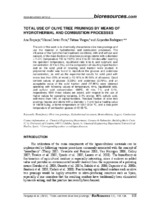Total use of olive tree prunings by means of hydrotermal and combustion processes
Autor
Requejo Silva, Ana
Feria, Manuel Javier
Vargas González, Fátima
Rodríguez Pascual, Alejandro
Editor
NC State UniversityFecha
2012Materia
BiorefineryOlive tree prunings
Hydrothermal treatment
Hemicellulose
Sugars
Combustion
METS:
Mostrar el registro METSPREMIS:
Mostrar el registro PREMISMetadatos
Mostrar el registro completo del ítemResumen
The aim of this work is to chemically characterize olive tree prunings and use the material in hydrothermal and combustion processes. The influence of the hydrothermal treatment conditions, with and without acid catalyst, of the main fraction of olive tree prunings (stems with a diameter > 1 cm) (temperature 150 to 190ºC, time 0 to 20 minutes after reaching the operation temperature, liquid/solid ratio 6 to 8, and sulphuric acid concentration -0.1 to 0.5%), on the composition of resulting liquid fraction and on the solid yield of resulting solid fraction were studied. A polynomial model was found to reproduce the glucose and arabinose concentration, as well as the experimental results for solid yield with errors less than 20% at worst (< 10-12% in 90-95% of all cases). Good content values of glucose (5.33%) and arabinose (2.76%), and an acceptable value of the solid fraction yield (57.96%) were obtained operating with following values of temperature, time, liquid/solid ratio, and sulfuric acid concentration: 186ºC, 18 min, 7:1, and 0.1%, respectively. With these values are saved, with respect to the use of higher values for operating variables, 2.1% energy, 80% sulfuric acid, and more than 10% of capital facilities. Residual fraction of olive tree prunings (leaves and stems with a diameter < 1 cm) had a heating value of 18699 kJ/kg, a flame temperature of 1207-2234 ºC, and a dew point temperature of combustion gasses of 45-53 ºC.

